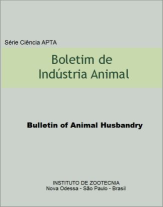Supply of cashew bagasse for haemonchus contortus control in sheep
Palavras-chave:
Agroindustrial residues, medicinal plants, phytotherapyResumo
Due to the inadequate and non-targeted use of anthelmintics, helminthiasis is a common disease in small ruminants. Currently, the panorama is of strong parasitic resistance to most anthelmintics, besides concern over the existence of residues in food and the environment. Since phytotherapy can be employed to mitigate the use of veterinary drugs, a great deal of research into natural bioactive compounds to control animal diseases has been carried out. Antiparasitic activities have been attributed to substances present in cashew fruit, Anacardium occidentale, so the aim of this study was to evaluate whether the ingestion of cashew bagasse would reduce infection by Haemonchus contortus in artificially infected Santa Inês sheep. The plant fiber was obtained from the processing of cashew peduncles, which received water and Pectinex Ultra SP. The material was pressed six times in an expeller and dried at 60 °C for 48 h. Twenty-one animals were completely dewormed and after 15 days they were infected with 4,000 L3 of H. contortus. After 28 days, the ewes were individually allocated in metabolic cages and divided into groups (n = 7/group) according to the weight and number of eggs per gram of feces (EPG): G1: negative control (no treatment), G2: treatment with anthelmintic (Zolvix®, 2.5 mg / kg BW) and G3: cashew bagasse for 29 days (0.3% PV - 7 days of adaptation from D-7 to D0). All of them received corn silage during the experimental period. Individual leftovers and feed were weighed daily and samples were frozen weekly for dry matter analysis. Dry matter and total phenolic analysis after MEOH extraction from cashew fiber was also performed. The animals were weighed weekly to adjust the diet according to weight and the individual EPG count was performed twice a week. Data were submitted to analysis by the Duncan test (p<0.05). The cashew bagasse contained 93.6% DM, 13.0% CP, 68.7% NDF, 47.6% ADF, 1.3% MM, 1.9% EE, 22.3% LIG and 26, 4% DMIVD. In relation to total phenolics, the content was 62.5 mg of gallic acid/g bagasse. After 29 days, the mean EPG counts of the control, anthelmintic and cashew bagasse groups were 3499.0, 14.3 and 2070.4, respectively, which were statistically different between each other. For those three groups, the mean weight gains were 3.06, 3.20 and 2.24 kg, respectively. In relation to the negative control group, the anthelmintic showed efficacy of 99.6% and cashew bagasse of 44.8%. The analysis of the material demonstrated its richness in relation to the amount of crude protein, digestible energy and antioxidant compounds, in addition to also making weight gain possible. Thus, in regions where cashew bagasse is available at low cost, its use as an adjuvant in H. contortus control can be encouraged, mitigating the use of veterinary drugs, reducing environmental contamination by agroindustrial residues and promoting the production of small ruminants in a more sustainable way, especially in the Northeast region of Brazil.
Downloads
Downloads
Publicado
Edição
Seção
Licença
Os autores não serão remunerados pela publicação de trabalhos, pois devem abrir mão de seus direitos autorais em favor deste periódico. Por outro lado, os autores ficam autorizados a publicar seus artigos, simultaneamente, em repositórios da instituição de sua origem, desde que citada a fonte da publicação original seja Boletim de Indústria Animal. A revista se reserva o direito de efetuar, nos originais, alterações de ordem normativa, ortográfica e gramatical, com vistas a manter o padrão culto da língua e a credibilidade do veículo. Respeitará, no entanto, o estilo de escrever dos autores. Alterações, correções ou sugestões de ordem conceitual serão encaminhadas aos autores, quando necessário. Nesses casos, os artigos, depois de adequados, deverão ser submetidos a nova apreciação. As opiniões emitidas pelos autores dos artigos são de sua exclusiva responsabilidade. Todo o conteúdo deste periódico, exceto onde está identificado, está licenciado sob a Licença Creative Commons Attribution (CC-BY-NC). A condição BY implica que os licenciados podem copiar, distribuir, exibir e executar a obra e fazer trabalhos derivados com base em que só se dão o autor ou licenciante os créditos na forma especificada por estes. A cláusula NC significa que os licenciados podem copiar, distribuir, exibir e executar a obra e fazer trabalhos derivados com base apenas para fins não comerciais.













